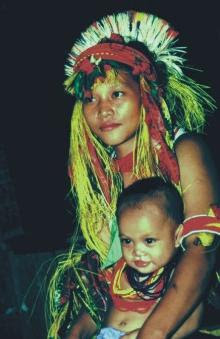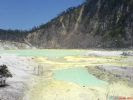Java Island
Jakarta has been called a study in contrasts : traditional and modern ; rich and poor ; spiritual and worldly stand side by side in this bustling metropolis. Among the 8 million people who call Jakarta home, one finds representatives of the many diverse ethnic and cultural groups which shape Indonesia, a reminder of the nation's motto : "Unity in Diversity". You may have to search high and low in this multi-cultural collage to find one of the proud ethnic Jakartans, called "Orang Betawi". Their language, Betawi Malay, has two variations, conventional Betawi Malay, spoken by elder people born and bred in Jakarta, and modern Jakarta Malay, a slang form spoken by the younger generation and migrants.
Jakarta is the port of entry for many tourists and business people. It is home to a dynamic contrast between Western - style skyscrapers, modern urban life-styles and traditional Indonesian culture. Its rapid growth into a metropolitan city reflects the economic, political, social and industrial development of the nation. In recent years, Jakarta has expanded its facilities for visitors with luxury hotels, fine restaurants, exciting night life and modern shopping centers. It contains many tourist attractions such as Taman Mini Indonesia Indah (Beautiful Indonesia in Miniature Park), restored colonial period buildings, islands resorts in the Pulau Seribu ( Thousand Islands ), and an extensive beach recreation complex called Ancol.
The nation's capital, Jakarta, has a remarkable history. Its history as a trading center started as a small harbor town called Sunda Kelapa, but its actual founding dates back to the year 1527, when it was named Jayakarta by Fatahillah of the neighboring Sultanate of Banten. The name Jayakarta means City of great Victory. During the 17th century it served as the capital of the Dutch East Indies with the name Batavia.
Reminders of this period can still be seen today in the architecture of some of the northern parts of the city. When Indonesian independence was finally secured it was renamed Jakarta, and serves today as the center of government, business and industry, spreading over an area of more than 650 sq.km (410 sq miles ). Jakarta's architecture reflects the history of outside influences which came and left their mark on this vital seaport city. The Taman Fatahillah Restoration Project, begun in the early 1970's, has restored one of the oldest sections of Jakarta, known as Old Batavia or Kota, to one of the most picturesque areas of the entire city. An Old Portuguese Church and warehouse have been reincarnated as living museums. The Old Supreme Court Building is now the National Museum of Fine Arts and houses part of the superb Chinese porcelain collection of former Vice-President Adam Malik. The Old Town Hall has become the Jakarta Museum, displaying such rare items as old Indonesians historical documents and Dutch period furniture. Even the city's tower clock was returned to England to be repaired under its lifetime guarantee, a lifetime which has now stretched over hundreds of years !
As Indonesia's main gateway, Jakarta's Soekarno Hatta International Airport is the central transportation hub of Indonesia. It serves a growing number of international airlines and is the nexus point for domestic flights across the vast expanse of the archipelago. Local transport in all forms within the city is readily available.
The province of West Java is located in the Island of Java. Java is part of the Greater Sunda group of islands which consists of Sumatra, Kalimantan, Sulawesi and Java as the main islands. It is in this region where a majority of the Indonesian population lives. And it is also in this region where the main economic activities of Indonesia are conducted.
The province of West Java with Bandung as the capital city came into existence on July 14,1950, under law Number 11 of 1950. The province of West Java today comprise 26 level II regions, which are divided into 20 districts and 6 municipalities. West Java is, geographically, divided into 3 (three) parts, ie. the Northern, Central and Southern parts of West Java. The Southern part of West Java is an upland strip / plateau that stretches from Ujung Kulon (Pandeglang) to Nusa Kambangan (the South coast plain of Ciamis).
As a means of transportation, the road network in South West Java has nearly all been asphalted. To increase and facilitate access to the flow of goods and people as well as to support tourism potential, the Southern road network is under construction to connect each district, from Labuhan at the west end to Pangandaran in the east. The network is 605 km in length and has several bridges over the rivers that flow in to the Indonesia Ocean.
This province combines many of the most important Industrial Zones in Indonesia and also has the exteded recreation areas along the western coast of Java and in the south the Ujung Kulon National Park and the mountainous areas which are home to the Baduy people. An endless variety!
Banten has the easiest access to Jakarta being merely an enclave in this province. This province uses its own unique culture and language, both called Sundanese which is also used to call its people. The ancient kingdoms of Tarumanegara, Pajajaran, Banten and Cirebon would make interesting studies for the student of archaeology Cirebon is located on the border between West and Central Java, having a mixed culture originating from the ancient Cirebon and Banten kingdoms, resulting in similar customs and dialects of the two people, although the city of Banten is located at the extreme western part of the province.
The city of Banten on Banten Bay was one of the first palces to begin trade with the Dutch. There is little to see of the past glories of this area today with the exception of the Grand Mosque which was completed in the year 1599 and is certaily worth a visit.
The Province has a great number of attractions, from the wildlife reserve of Ujung Kulon on the south-western tip of Java and the isolated communities of the mysterious Baduy to the unspoiled beaches. The villages are busy and attractive and the pace of life gets slower as you move towards the National Park in the south west.
From any point along the western coast you can see the "son of Krakatoa" volcano which rises impressively from the sea. To hire a boat to go there will cost about $150 and the journey takes about five hours. It has a number of sea resorts on its western coast which have modern hotels and are popular during weekends and holiudays.
Banten offers many different recreational experiences. The trip to the Anyer area from Jakarta is now quick and easy because of the toll road which connects the port of Merak with Jakarta. As you move further south along the west Java coast the lifestyle becomes more relaxed and after Labuan you move into more rural areas where the road conditions worsen and the lifstyle is relaxed. Here access to the forest areas begins and you can move back in time and enjoy the peace of nature. There is a bus each day from Labuan to Taman Jaya which is on the edge of the Ujung Kulon national park. There simple cabins can be hired and a ranger can then take you on a walk into the park. It takes about six hours to reach a camping site. Food is not readily available so take some with you from Matahari in Labuan! This is the cheapest way to get into the National Park. Boats from and of the west coast ports will also take you into the park often using the islands of Panaitan, Peucan and Handeuleum where accommodation is also available. Contact us through our email contact below for more information on ths park or proceed directl;y to the park office at Labuhan.
Solo is the city that never sleeps. As a business and cultural city, Solo's night life has never appeared to cease. At night, people usually enjoy the traditional food of Liwet rice along with a cup of tea, in the Keprabon, an area in Yogyakarta where locals usually gather for traditional meals.
Cultural tradition has also been passed through generations. With the two Sultanates in the city, Kasunanan and Mangkunegaran, Solo's cultural values have grown among the younger generation. Local government of the city has always nurtured ritual traditions, such as Maleman Sriwedari (celebrations welcoming the fasting month for the Moslems) , Kirab Pusaka (ritual of cleaning up inherited traditional swords), Grebeg Maulud and the Sekatenan (both celebrations of Prophet Mohammad's birth), Tourists in Yogyakarta wishing to see the Ramayana dance at Prambanan temple, can join travel and tour packages offered by tour operators in Yogyakarta, through hotels all over the city. Tickets can be purchased individually from hotels and tour operators in Yogyakarta.
Tourists should seek and confirm the show schedules first, before making the trip. As for the transportation to Prambanan, the temple's officials have provided shuttle buses with the price of Rp 15.000 ( US 2 ) one way, which is a cheap and comfortable option, rather than taking public transport.
Lying in the shadow of the aptly named "Fire Mountain", (2914 meter-high active volcano, Mt.Merapi), is the seat of the once mighty Javanese Empire of Mataram, Ngayogyakarto Hadiningrat.Yogyakarta (Yogya) came into being in 1755, when a land dispute split the power of Mataram into the Sultanates of Yogyakarta and Surakarta (solo). Prince Mangkubumi built Kraton of Yogyakarta and created one of the most powerful Javanese states ever. The Kraton is still the hub of Yogyakarta's traditional life and despite the advance of the refinement which has been the hallmark of its art and people for centuries.
Yogyakarta is one of the supreme cultural centers of Java. Full Gamelan orchestras keep alive the rhythms the past, classical Javanese dances entrance with visions of beauty and poise, shadows come to life in the stories of the Wayang kulit and a myriad of traditional visual art forms keep locals and visitors alike spell-bound. Yogya has an extraordinary life force and charm which seldom fails to captivate.
Contemporary art has also grown in the fertile soil of Yogyakarta's sophisticated cultural society. ASRI, the Academy of Fine Arts, is the centre of the arts in the region and Yogyakarta has given its name to an important school of modern painting in Indonesia, best illustrated by the renowned impressionist, the late Affandi.
The province is one of the most densely populated areas of Indonesia. It stretches from the slopes of mighty Mount Merapi in the North to the wave - swept beaches of the powerful Indian Ocean to the South.
Little of the Majapahit Empire's former glory still stands in East Java. Nevertheless, East Java has a variety of attractions, ranging from temple sites to unspoiled beaches, stunning volcanoes, extra ordinary highland lakes, resplendent marine parks and fantastic wildlife reserves. Magnificent mountain scenery includes the crater and legendary sea of sand at Mount Bromo, the "sulphur mountain" of Welirang and rugged Ijen Plateau. The island of Madura, famous for its bull races, is also part of the province and has its own traditions, culture and language.The provincial capital, Surabaya is second in size, population, and commerce only to Jakarta. It is also the most industrialized province in the nation with a strong economy based on agriculture, (coffee, mangoes and apples), fisheries and oil. The province is efficiently connected to the rest of Java by good roads, regular trains, and air services between Surabaya and other major cities in the country including Denpasar on Bali, which is only half an hour's flight away.


Comments
Post a Comment